It didn’t take long for the old depot to fall into ruin after the last Amtrak train departed on January 6, 1988, becoming the iconic symbol of Detroit’s decline. But later today, a sold-out ceremony will mark its rebirth as part of a nearly $1 billion project launched by Ford Motor Co. Michigan Central Station has become the centerpiece of a new campus focused on the development of advanced automotive technologies.
After decades serving as the reluctant archetype for urban decay, the City of Detroit is in the midst of a once-unlikely renaissance. Barely a decade out of bankruptcy, its credit rating has regained investment status and the population has, for the first time in more than seven decades, begun to rise again. Long-empty buildings
are finding new use, none generating more buzz than the reborn Michigan Central Station in Corktown, the Motor City’s oldest community.
The restoration of the depot has been the centerpiece of a nearly $1 billion project officially announced by Ford Motor Co. in May 2018. The automaker took over a handful of buildings, including a former school book depository and a deconsecrated church, covering a large chunk of the community. Still under renovation, the goal is to create a high-tech campus focusing on battery-electric, autonomous and connected vehicles, along with technologies expected to transform tomorrow’s automobiles.
“Michigan Central will advance mobility solutions that help solve some of society’s biggest challenges,” said Joshua Sirefman, the CEO. of the new Michigan Central Innovation District. “It will also be a powerful catalyst for growth and an economic engine for this region.”
High-tech campus
The first portion of the new Michigan Central campus officially opened in April 2023. The old book depository, renamed New Lab, became home to an initial list of 33 tenants which Ford described as a mix of “startups, entrepreneurs, engineers and scientists.” They covered a broad range of business and technology fields, from 3D modeling to one firm developing a robotic tire-changing system.
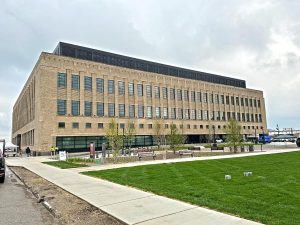
The Michigan Central Station is one of numerous buildings Ford has brought back to life in its new campus, including an old school book depository renamed NewLab.
Ford itself will operate out of several buildings – though it plans to only occupy three floors in the 18-story former train station.
Some of the projects the automaker and those start-ups are working on will literally spill over onto the streets of the Corktown neighborhood, Sirefman explained during an interview with Headlight.News.
One stretch alongside the Michigan Center has become “the first road in the country with in-road charging,” he said, noting that the goal is to see whether it would be possible – and practical – to set up roadways allowing EVs to charge up using inductive technology, much like what’s used for cellphones and smartwatches.
Beyond business
The reborn Michigan Central will also features new shopping, dining and community activity spaces, according to Bill Ford, the automaker’s executive chairman and great-grandson of founder Henry Ford.
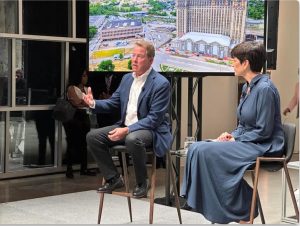
Plenty of folks initially questioned Ford Chairman Bill Ford’s sanity when he decided to buy the decrepit train station.
“I wanted Michigan Central to be beautifully restored but also reimagined for so much more,” said Ford, who became the internal advocate for the project.
“This will be a place for the community to enjoy and a destination for visitors from all over. We will have restaurants, music, art, and great retail. And the innovation that will happen here, with startups and companies big and small, will help ensure Detroit preserves its title as the Motor City for generations to come.”
More High-Tech News
- Shift to PHEVs and Range-Extenders Accelerates
- Jeep Will Offer 6 Powertrain Options – 5 of Them Electrified
- All-Electric Volvo EX90 Finally Enters Production – 2 Years Late
Ruin porn
First opened in 1914 the Michigan Central Station was, at the time, the largest railroad depot in the world – and the tallest, at 18 stories. With its striking Beaux-Arts architecture, it was one of the Motor City’s most iconic buildings and in next quarter-century was the first place visitors – and the many migrants to the city — saw during an era when Detroit was one of America’s richest and fastest-growing cities.
By the end of World War II, however, the city’s primary product – automobiles – had cut into the nation’s passenger rail service, a shift made worse as “white flight” began to drive an exodus to the suburbs. When Amtrak ended service at the Michigan Central in 1988, it was shuttered to the public. The only visitors were those sneaking in through gaps in the fencing to find shelter, steal artifacts or take pictures – the station a popular “ruin porn” site.
For decades, Michigan Central Station was the object of an ongoing debate: whether to simply level the crumbling structure or bring it back to life. There were several half-hearted attempts to stabilize the building. In 2010, new windows were installed. But its prior owners showed little interest in taking the next step.
“An enormous amount of damage”
That the station hadn’t collapsed surprised some observers. “There was an enormous amount of damage,” Sirefman said, much of it caused by water. It took 18 months to pump out 3.5 million gallons that collected in the facility’s lower floors, he noted.
And that was just the beginning. There was significant damage to the outer structure and inner facades. Much of the grand ornamentation was either missing or destroyed. But Ford’s plan was to effectively restore the facility to its original grandeur.
“It took an incredible effort to research the old plans to simply understand how to recreate the original conditions,” said Sirefman.
The next challenge was to repair or replace the missing pieces, from the capitals atop exterior columns, to the huge clock in the interior concourse.
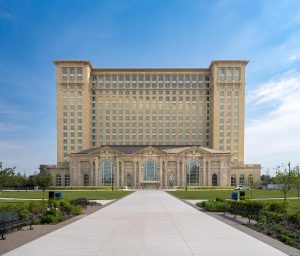
Ford was able to get the original quarry used for the station to reopen so it could match exterior stonework.
Reopening a quarry
In several ways, the redevelopment team lucked out, Sirefman said. As word spread, a number of people who – one way or the other – had come into possession of various parts and pieces of the old station volunteered to return them. In some cases, the company could then take digital renderings and use 3D modeling to recreate other missing bits.
An equal challenge was matching the damaged and missing exterior stonework, he noted, adding that “We found the original quarry which was closed. We contacted the owner who agreed to open it back up specifically for Ford.”
Sirefman declined to discuss what such efforts cost, but the Michigan Central Station restoration is widely believed to have eaten up the vast share of the total project’s $950 million.
Some changes
Not everything is back to original. There have been design changes reflecting the new uses the station will be put to, including a hotel.
In one section of the depot, Ford has worked to maintain some of the graffiti that accumulated over the years as a reminder of what the depot has gone through.
The project remains a work-in-process, meanwhile. A hotel operator has yet to be confirmed, for one thing. Separately, there “have been discussions” with Amtrak, said Sirefman, “for the possibility passenger rail (service) would return. We’re optimistic that will happen.” Better yet, he added, there is talk of a significant expansion of regional rail service, including a direct link not only to more Midwest destinations but to Windsor, the Canadian city across the Detroit River, and Toronto beyond.
Ironically, one of the changes Ford has made is to complete the six top floors of the Michigan Central Station which never were finished in its original form for lack of occupants.

Detroit native Diana Ross will headline the party when the Michigan Central Station officially reopens on the evening of June 6, 2024.
Celebrating the grand reopening
The rebirth of the old station was to be marked by a major series of events starting the evening of June 6. The centerpiece was to be a concert featuring a raft of celebrities including Detroit natives Diana Ross, Jack White, Big Sean and Eminem, as well as the Detroit Symphony Orchestra. Visitors scheduled to perform include Melissa Etheridge and Jelly Roll.
It will air on local NBC affiliate WDIV, along with the Peacock network, starting at 8:30 PM. NBC will edit it down to a prime-time special starting Sunday June 9 at 7:00 PM EDT.


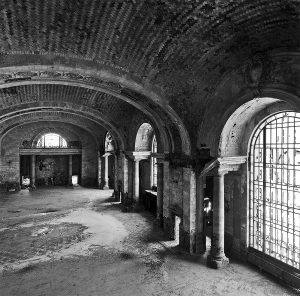
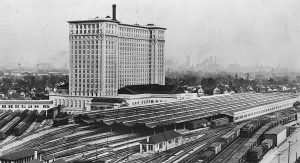
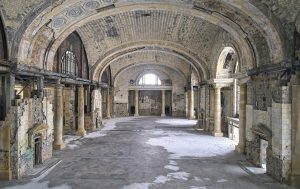
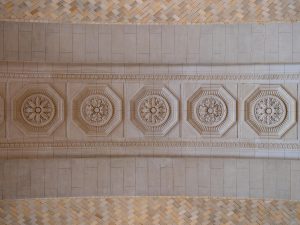


0 Comments